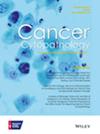Hepatocyte nuclear factor 4 alpha immunocytochemistry: A useful marker for detecting endocervical glandular lesions in alcohol-fixed smears
Abstract
Background
Hepatocyte nuclear factor 4 alpha (HNF4α) contributes to tumorigenesis and cancer progression. This study evaluated the diagnostic potential of HNF4α for detecting endocervical glandular lesions (EGLs), including endocervical adenocarcinomas (ECAs), adenocarcinomas in situ (AIS), and lobular endocervical glandular hyperplasias (LEGH) using alcohol-fixed cytological smears.
Methods
HNF4α expression was immunocytochemically assessed in alcohol-fixed smears and paired formalin-fixed paraffin-embedded tissue specimens obtained from 14 patients with histologically confirmed EGLs: eight papillomavirus-associated (HPVA) ECAs, one non-NHPVA ECA, two HPVA AIS, and three patients with LEGHs. Three cases of squamous cell carcinomas (SCCs) and two cases of non-neoplastic lesions were also analyzed as non-EGL controls. HNF4α positivity was defined as nuclear staining in one or more cell(s)/slide, regardless of intensity.
Results
Histologically confirmed EGL cases were cytologically diagnosed as four adenocarcinomas, eight atypical glandular cells, one misclassified atypical squamous cells of undetermined significance, and one misclassified SCC, with a sensitivity of 85.7% and specificity of 100%. Strong and diffuse nuclear HNF4α expression was observed in atypical glands in both smears and tissue specimens, whereas non-neoplastic glands and non-neoplastic/neoplastic squamous epithelium were HNF4α-negative. HNF4α expression showed 73.7% concordance between tissue and smear samples. Notably, HNF4α immunocytochemistry demonstrated 100% sensitivity and specificity for detecting EGLs, outperforming cytomorphological or immunohistochemical diagnosis (sensitivity, 71.4%; specificity, 100%).
Conclusions
HNF4α is a reliable diagnostic marker when using alcohol-fixed smears, showing enhanced accuracy for EGLs detection regardless of human papillomavirus status. Immunocytochemical analysis of HNF4α in cervical smears can be used for EGL detection and early diagnosis of cervical cancer.





 求助内容:
求助内容: 应助结果提醒方式:
应助结果提醒方式:


